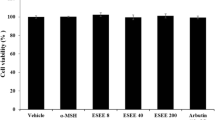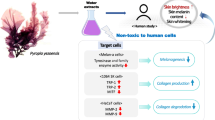Abstract
Premature aging can occur due to excessive sun exposure which causes hyperpigmentation problems and causes brown or black patches on the skin. Duku (Lansium domesticum Corr.) contains flavonoids and vitamin C compounds that are effective in protecting the skin from sun exposure. This study aims to see the benefits of the extract of the seeds and peel of duku fruit (Lansium domesticum Corr.) On the amount of melanin pigment in the skin of mice (Mus musculus) as an anti-hyperpigmentation so that the dapjekal is a skin pen. Group P0 was a negative control, group P1 was exposed to sunlight for 20 days, group P2 mice were exposed to duku seed extract and then exposed to sunlight for 20 days, group P3 were exposed to duku peel and exposed to local sunlight for 20 days, P4 mice were exposed to sunlight 20 days, 21–30 days exposed to peel extract, and P5 mice exposed to sunlight 20 days, 21–30 days exposed to seed extract. The results showed that the P0 group had the amount of melanin pigment with an average of 7 grains, the P1 group: 68.4, P2 group: 26.6, P3 group: 29, P4 group: 7.2, and group P5 group: 12. The conclusion is that exposure to sunlight the amount of melanin pigment and offers the extract of the peel and seeds of duku fruit can reduce the amount of melanin pigment.








Similar content being viewed by others
References
Abotaleb M, Liskova A, Kubatka P (2020) Therapeutic potential of plant phenolic acids in the treatment of cancer. Biomolecules 10:221. https://doi.org/10.3390/biom10020221
Addor FAS (2017) Antioxidant in dermatology. An Bras Dermatol 92(3):356–362
Bergman ME, Davis B, Phillips MA (2019) Occurrence, and mechanism of action. Molecules 24(21):1–23
Burns EM, Tober KL, Riggenbach JA, Kusewitt DF, Young GS, Oberyszyn TM (2013) Differential effects of topical vitamin E and C E Ferulic® treatments on ultraviolet light B-induced cutaneous tumor development in Skh-1 mice. PLoS ONE 8:e63809
Charissa M, Djajadisastra J, Elya B (2016) Antioxidant activity test and tyrosinase inhibition and benefit test of taya bark extract gel (Nauclea subdita) against skin. Indones Pharm J 6(2):98–107
Cheeseman KH, Slater TF (1993) An introduction to free radical biochemistry. Br Med Bull 49:481–493
Choi M, Shin H (2016) Review: Antimelanogenesis effect of quercetin. Cosmetics 3(18):1–16. https://doi.org/10.3390/cosmetics3020018
Fadhilah K, Wahyuono S, Astuti P (2021) A sesquiterpene aldehyde isolated from ethyl acetate extract of Lansium domesticum fruit peel. Indones J Pharm 32(3):394–398. https://doi.org/10.22146/ijp.1884
Freitas JV, Praça FS, Bentley MV, Gaspar LR (2015) Trans-resveratrol and beta-carotene from sunscreens penetrate viable skin layers and reduce cutaneous penetration of UV-filters. Int J Pharm 484:131–137
Hanum L, Negara ZP, Dahlan Z (2018) Morphological diversity of Lansium domesticum Corr in South Sumatra. Sci Technol Indones 3(1):41–44. https://doi.org/10.26554/sti.2018.3.1.41-44
Hanum L, Kasiamdari R (2013) Duku plant: bioactive compounds, pharmacological activities and prospects in the health sector. Papuan Biol J 5(2):84–93
Huda S, Wiraguna A, Pangkahila W (2017) Passion fruit (Pasiflora edulis) extract cream was as effective as 4% hydroquinone cream in inhibiting the increase in the amount of melanin in the skin of male guinea pigs (Cavia porcelus) exposed to UV-B rays. Biomed J 9(1):1–6
Katiyar SK, Mukhtar H (2001) Green tea polyphenol (-)-epigallocatechin-3-gallate treatment to mouse skin prevents UVB-induced iniltration of leukocytes, depletion of antigen-presenting cells, and oxidative stress. J Leukoc Biol 69:719–726
Klungsupya P, Suthepakul N, Muangman T, Rerk-Am U, Thongdon-A J (2015) Determination of free radical scavenging, antioxidative DNA damage activities and phytochemical components of active fractions from Lansium domesticum corr. Fruit Nutr 7(8):6852–6873. https://doi.org/10.3390/nu7085312
Kohen R, Fanberstein D, Tirosh O (1997) Reducing equivalents in the aging process. Arch Gerontol Geriatr 24:103–123
Kvam E, Dahle J (2003) Pigmented melanocytes are protected against ultraviolet-A-induced membrane damage. J Invest Dermatol 121:564–569
Layuck A, Lintong P, Loho L (2015) Effect of lime juice (Citrus aurantifolia) on the amount of melanin pigment in the skin of mice (Mus musculus) exposed to sunlight. J e-Biomed 3(1):1–6
Lubis MF, Hasibuan PA, Syahputra H (2022) A review on phytochemicals and pharmacological activities as ethnomedicinal uses of duku (Lansium domesticum Corr). J Med Sci 10(F):57–65
Mamoto N, Kalangi S, Karundeng R (2009) The role of melanocortin in melanocytes. J e-Biomed 1(1):1–11
Manosroi A, Jantrawut P, Sainakham M, Manosroi W, Manosroi J (2012) Anticancer activities of the extract from Longkong (Lansium domesticum) young fruits. Pharm Biol 50(11):1397–1407. https://doi.org/10.3109/13880209.2012.682116
Oresajo C, Yatskayer M, Galdi A, Foltis P, Pillai S (2010) Complementary effects of antioxidants and sunscreens in reducing UV-induced skin damage as demonstrated by skin biomarker expression. J Cosmet Laser Ther 12:157–162
Preedy VR (2012) Handbook of diet, nutrition and the skin. Wageningen Academic Publishers, Wageningen
Sallam IE, Abdelwareth A, Attia H, Aziz RK, Homsi MN, von Bergen M et al (2021) Effect of gut microbiota biotransformation on dietary tannins and human health implications. Microorganisms 9(5):965. https://doi.org/10.3390/microorganisms9050965
Sarkar R, Arora P, Garg VK, Sonthalia S, Gokhale N (2014) Melasma update. Indian. Dermatol Online J 5:426–435
Schroeder P, Krutmann J (2010) What is needed for a sunscreen to provide complete protection. Skin Ther Lett 15:4–5
Sofiana R, Wiraguna A, Pangkahila W (2017) Noni (Morinda citrifolia) seed ethanol extract cream is as effective as hydroquinone cream in preventing an increase in the amount of melanin in the skin of guinea pigs (Cavia porcellus) exposed to ultraviolet light. Biomedicine 5(1):1–6
Subadrant S et al (2016) Antioxidant potential of duku (Lansium domesticum Corr) seed extract in alcohol induced male white rat (Rattus novergicus). Molecules 11(1):1–8
Suryaningsih B, Soebono H (2016) Melanocyte biology. Media Dermato- Venereologica Indonesiana 43(2):78–82
Techavuthiporn C (2018) Langsat Lansium domesticum. Elsevier Inc., Amsterdam
Yamaguchi Y, Brenner M, Hearing VJ (2007) The regulation of skin pigmentation. J Biol Chem 282:27557–27561
Yonathan K, Lintong P, Durry M (2016) Effect of cocoa (Theobroma cacao) seed extract on the amount of melanin pigment in the skin of Wistar rats (Rattus novergicus) exposed to sunlight. J e-Biomed 4(2):1–7
Acknowledgements
The authors would like to appreciate the efforts ad contributions of the laboratory and technical staff during this research.
Funding
Funding Not Available.
Author information
Authors and Affiliations
Contributions
All the five authors reviewed the paper and contributed in developing the content.
Corresponding author
Ethics declarations
Ethical statement
Study ethics this research was conducted according to ethical standards for the use of animals for scientific purposes. The research protocol obtained an ethical review from the Faculty of Public Health, University of Sriwijaya with registration number: 219/UN9.1.10/KKE/2020.
Conflict of interest
Delima Engga Maretha has no conflict of interest. Dini Afriansyah has no conflict of interest. Dewi Susilo Wati has no conflict of interest. Mashuri Masri has no conflict of interest. Ade Rizky Dwiyanti has no conflict of interest. Muhammad Ifham Hanif has no conflict of interest. Slamet Wardoyo has no conflict of interest.
Additional information
Publisher's Note
Springer Nature remains neutral with regard to jurisdictional claims in published maps and institutional affiliations.
Supplementary Information
Below is the link to the electronic supplementary material.
Rights and permissions
About this article
Cite this article
Maretha, D.E., Afriansyah, D., Wati, D.S. et al. Test comparison of seeds and skins extract of duku’s fruit (Lansium domesticum Corr.) against the amount of melanin pigment of skin mencit (Mus musculus) to prevent premature aging of the skin. ADV TRADIT MED (ADTM) 22, 875–883 (2022). https://doi.org/10.1007/s13596-022-00651-5
Received:
Accepted:
Published:
Issue Date:
DOI: https://doi.org/10.1007/s13596-022-00651-5




